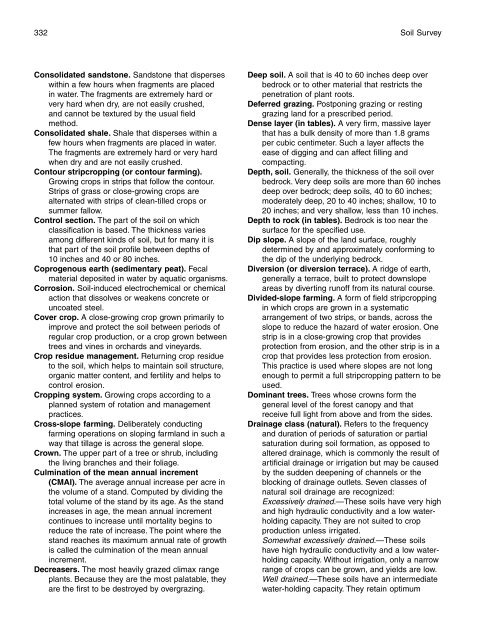Soil Survey of Sweet Grass County Area, Montana - Soil Data Mart
Soil Survey of Sweet Grass County Area, Montana - Soil Data Mart
Soil Survey of Sweet Grass County Area, Montana - Soil Data Mart
Create successful ePaper yourself
Turn your PDF publications into a flip-book with our unique Google optimized e-Paper software.
332 <strong>Soil</strong> <strong>Survey</strong><br />
Consolidated sandstone. Sandstone that disperses<br />
within a few hours when fragments are placed<br />
in water. The fragments are extremely hard or<br />
very hard when dry, are not easily crushed,<br />
and cannot be textured by the usual field<br />
method.<br />
Consolidated shale. Shale that disperses within a<br />
few hours when fragments are placed in water.<br />
The fragments are extremely hard or very hard<br />
when dry and are not easily crushed.<br />
Contour stripcropping (or contour farming).<br />
Growing crops in strips that follow the contour.<br />
Strips <strong>of</strong> grass or close-growing crops are<br />
alternated with strips <strong>of</strong> clean-tilled crops or<br />
summer fallow.<br />
Control section. The part <strong>of</strong> the soil on which<br />
classification is based. The thickness varies<br />
among different kinds <strong>of</strong> soil, but for many it is<br />
that part <strong>of</strong> the soil pr<strong>of</strong>ile between depths <strong>of</strong><br />
10 inches and 40 or 80 inches.<br />
Coprogenous earth (sedimentary peat). Fecal<br />
material deposited in water by aquatic organisms.<br />
Corrosion. <strong>Soil</strong>-induced electrochemical or chemical<br />
action that dissolves or weakens concrete or<br />
uncoated steel.<br />
Cover crop. A close-growing crop grown primarily to<br />
improve and protect the soil between periods <strong>of</strong><br />
regular crop production, or a crop grown between<br />
trees and vines in orchards and vineyards.<br />
Crop residue management. Returning crop residue<br />
to the soil, which helps to maintain soil structure,<br />
organic matter content, and fertility and helps to<br />
control erosion.<br />
Cropping system. Growing crops according to a<br />
planned system <strong>of</strong> rotation and management<br />
practices.<br />
Cross-slope farming. Deliberately conducting<br />
farming operations on sloping farmland in such a<br />
way that tillage is across the general slope.<br />
Crown. The upper part <strong>of</strong> a tree or shrub, including<br />
the living branches and their foliage.<br />
Culmination <strong>of</strong> the mean annual increment<br />
(CMAI). The average annual increase per acre in<br />
the volume <strong>of</strong> a stand. Computed by dividing the<br />
total volume <strong>of</strong> the stand by its age. As the stand<br />
increases in age, the mean annual increment<br />
continues to increase until mortality begins to<br />
reduce the rate <strong>of</strong> increase. The point where the<br />
stand reaches its maximum annual rate <strong>of</strong> growth<br />
is called the culmination <strong>of</strong> the mean annual<br />
increment.<br />
Decreasers. The most heavily grazed climax range<br />
plants. Because they are the most palatable, they<br />
are the first to be destroyed by overgrazing.<br />
Deep soil. A soil that is 40 to 60 inches deep over<br />
bedrock or to other material that restricts the<br />
penetration <strong>of</strong> plant roots.<br />
Deferred grazing. Postponing grazing or resting<br />
grazing land for a prescribed period.<br />
Dense layer (in tables). A very firm, massive layer<br />
that has a bulk density <strong>of</strong> more than 1.8 grams<br />
per cubic centimeter. Such a layer affects the<br />
ease <strong>of</strong> digging and can affect filling and<br />
compacting.<br />
Depth, soil. Generally, the thickness <strong>of</strong> the soil over<br />
bedrock. Very deep soils are more than 60 inches<br />
deep over bedrock; deep soils, 40 to 60 inches;<br />
moderately deep, 20 to 40 inches; shallow, 10 to<br />
20 inches; and very shallow, less than 10 inches.<br />
Depth to rock (in tables). Bedrock is too near the<br />
surface for the specified use.<br />
Dip slope. A slope <strong>of</strong> the land surface, roughly<br />
determined by and approximately conforming to<br />
the dip <strong>of</strong> the underlying bedrock.<br />
Diversion (or diversion terrace). A ridge <strong>of</strong> earth,<br />
generally a terrace, built to protect downslope<br />
areas by diverting run<strong>of</strong>f from its natural course.<br />
Divided-slope farming. A form <strong>of</strong> field stripcropping<br />
in which crops are grown in a systematic<br />
arrangement <strong>of</strong> two strips, or bands, across the<br />
slope to reduce the hazard <strong>of</strong> water erosion. One<br />
strip is in a close-growing crop that provides<br />
protection from erosion, and the other strip is in a<br />
crop that provides less protection from erosion.<br />
This practice is used where slopes are not long<br />
enough to permit a full stripcropping pattern to be<br />
used.<br />
Dominant trees. Trees whose crowns form the<br />
general level <strong>of</strong> the forest canopy and that<br />
receive full light from above and from the sides.<br />
Drainage class (natural). Refers to the frequency<br />
and duration <strong>of</strong> periods <strong>of</strong> saturation or partial<br />
saturation during soil formation, as opposed to<br />
altered drainage, which is commonly the result <strong>of</strong><br />
artificial drainage or irrigation but may be caused<br />
by the sudden deepening <strong>of</strong> channels or the<br />
blocking <strong>of</strong> drainage outlets. Seven classes <strong>of</strong><br />
natural soil drainage are recognized:<br />
Excessively drained.—These soils have very high<br />
and high hydraulic conductivity and a low waterholding<br />
capacity. They are not suited to crop<br />
production unless irrigated.<br />
Somewhat excessively drained.—These soils<br />
have high hydraulic conductivity and a low waterholding<br />
capacity. Without irrigation, only a narrow<br />
range <strong>of</strong> crops can be grown, and yields are low.<br />
Well drained.—These soils have an intermediate<br />
water-holding capacity. They retain optimum
















